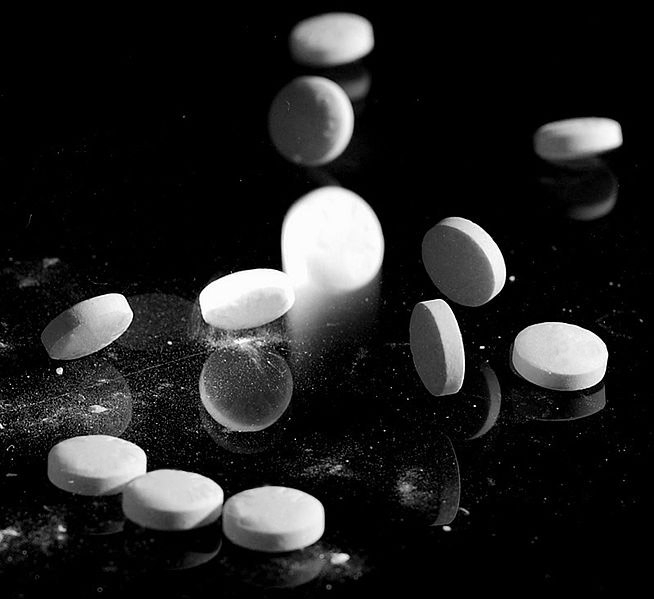

Article by Brazilian researchers in The Journal of Clinical Pharmacology finds benefits of new therapeutic scheme to be equivalent to daily dose, with a lower risk of gastrointestinal complications (photo: Wikimedia Commons)
Article by Brazilian researchers in The Journal of Clinical Pharmacology finds benefits of new therapeutic scheme to be equivalent to daily dose, with a lower risk of gastrointestinal complications.
Article by Brazilian researchers in The Journal of Clinical Pharmacology finds benefits of new therapeutic scheme to be equivalent to daily dose, with a lower risk of gastrointestinal complications.

Article by Brazilian researchers in The Journal of Clinical Pharmacology finds benefits of new therapeutic scheme to be equivalent to daily dose, with a lower risk of gastrointestinal complications (photo: Wikimedia Commons)
By Karina Toledo | Agência FAPESP – A low dose of acetylsalicylic acid (ASA) every three days can be just as effective as a daily dose at preventing heart attacks, strokes and peripheral vascular disease in patients at risk of these conditions, with the advantage that gastrointestinal complications are less likely.
This is the main finding of a Brazilian study supported by FAPESP and Biolab Farmacêutica. The results were published in The Journal of Clinical Pharmacology, and the article has recently been highlighted as an “Editor’s Choice”.
“ASA has been used for 50 years for the prevention of cardiovascular events, but constant use can cause gastric irritation and bleeding, often without prior symptoms. For this reason, attempts have been made to reduce the dose in recent years. Our study proposes a different therapeutic scheme,” said Gilberto De Nucci, a professor at the University of Campinas’s Medical School (FCM-UNICAMP) and the University of São Paulo’s Biomedical Science Institute (ICB-USP) and principal investigator for the Thematic Project to which the study is linked.
ASA inhibits the action of the enzyme cyclooxygenase (COX), De Nucci explained. In platelets, this reduces the production of thromboxane, a lipid that induces platelet aggregation. The drug “thins the blood,” as the saying goes, because it prevents platelets from forming blood clots. This is why it reduces the risk of heart attacks and strokes.
In the gastric mucosa, on the other hand, inhibition of COX reduces the production of prostaglandins, lipids that protect the stomach and intestinal lining.
“As originally marketed in the United States, ASA tablets contained 325 mg of the active ingredient. In an attempt to reduce adverse side effects, the dose was lowered to 162 mg and later to 81 mg. There are also tablets with 75 mg. But, if truth be told, we still don’t know for sure how much is needed to obtain cardiovascular benefits,” De Nucci said.
A dose of 81 mg was used in a clinical trial performed as part of Plinio Minghin Freitas Ferreira’s PhD research at the University of São Paulo (USP) under De Nucci’s supervision. Twenty-four healthy volunteers were divided into two groups. Half received ASA every day for a month. The rest took ASA every three days and a placebo on the other days.
All the volunteers were assessed before and after the trial by physical examination, endoscopy, gastric biopsy and platelet function assay, among other tests. Thromboxane levels in stored blood samples and prostaglandin E2 (PGE2) in gastric samples were also measured.
“In the group that took ASA every day, we observed a 50% decrease in PGE2 synthesis, whereas in the group that took the drug every three days no difference was observed compared with baseline levels,” De Nucci said. “In both groups, on the other hand, thromboxane inhibition exceeded 95% and platelet function test results were equivalent.”
According to Ferreira, the findings show that taking ASA every 72 hours is just as effective as taking it every day, which means the drug could also be used for primary prevention of cardiovascular events.
The US Food & Drug Administration (FDA) currently recommends the use of ASA only for secondary prevention of cardiovascular disorders in patients diagnosed with peripheral vascular disease or those who have already had a heart attack or stroke and are at risk of a second event. Only in such cases do its benefits surpass the risk of adverse side effects, the FDA says.
“This new therapeutic approach enables ASA to be used to treat patients who have never had a cardiovascular event but are at high risk, such as diabetics,” Ferreira said.
Patent
In addition to being treated with ASA, both groups of participants in the clinical trial took losartan, an angiotensin receptor blocker used to treat high blood pressure (hypertension). According to De Nucci, the point was to show that the drugs do not interfere with each other.
A previous study by the same researchers, published in the Journal of Bioequivalence & Bioavailability, showed that ASA does not reduce losartan’s bioavailability. The two drugs are frequently co-administered to treat patients with heart failure, hypertension and ischemic diseases.
“We’ve applied for a US patent on the therapeutic scheme used in the study, in partnership with Biolab,” De Nucci said. “One of the possible applications would be to market a product that includes ASA and losartan or some other drug in the same blister pack. The patient would take both drugs on day one but only the anti-hypertensive and placebo on days two and three, and so on. That would help people take the medications correctly.”
The article “Acetylsalicylic acid daily vs acetylsalicylic acid every 3 days in healthy volunteers: effect on platelet aggregation, gastric mucosa, and prostaglandin E2 synthesis” (doi: 10.1002/jcph.685) can be read at onlinelibrary.wiley.com/doi/10.1002/jcph.685/full.
Republish
The Agency FAPESP licenses news via Creative Commons (CC-BY-NC-ND) so that they can be republished free of charge and in a simple way by other digital or printed vehicles. Agência FAPESP must be credited as the source of the content being republished and the name of the reporter (if any) must be attributed. Using the HMTL button below allows compliance with these rules, detailed in Digital Republishing Policy FAPESP.





